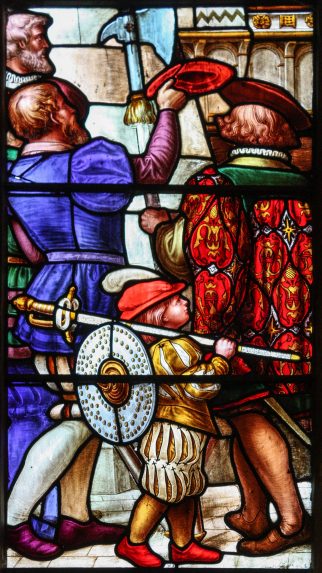Dover Town Hall - Maison Dieu, Dover, Kent
Address
Dover Town Hall - Maison Dieu, Biggin Street, Dover, Kent, CT16 1DWRecommended by
Highlight
6 large windows on historical subjects in the Stone HallArtist, maker and date
Designed by Sir Edward J Poynter in 1860. The first two windows were made and installed by William Wailes, 1860 and 1861, and the last four by Heaton, Butler & Bayne, 1864-73Reason for highlighting
This is a very imposing series of windows in a municipal building illustrating a secular subject, the medieval history of Dover, and is a rare work from the early stage of the career of this important artist, who subsequently served as President of the Royal Academy.
Artist/maker notes
Sir Edward John Poynter GVCO, RA, 1st Baronet (1836 –1919) was one of the most eminent of the classical painters of the Victorian period and, perhaps, the most distinguished of several painters who had an early involvement in stained glass, such as his brother in law, Edward Burne-Jones. He produced stained glass designs between 1857 and 1863, at which point his painting started to achieve success. He served as President of the Royal Academy between 1896 and 1918.
Sources:
Edward Poynter on Wikipedia
The Stained Glass Designs of Sir Edward Poynter by Alan Brooks in the Victorian Society Annual 1996 (A reduced version of the essay is available here – Sir Edward Poynter’s stained glass at the Maison Dieu)
Heaton, Butler & Bayne
Clement Heaton (1824-82) and James Butler (1830-1913) went into partnership in London in 1855. A close relationship with the firm of Clayton & Bell led to Clayton’s outstanding pupil, Robert Turnill Bayne (1837-1915), joining the firm in 1862. Bayne, along with his younger colleague, Alfred Hassam (1843-69) drove the firm’s development, and their windows from 1862 – c.1868 placed them in the top rank for that most creative period.
One of the largest and most prolific studios of the nineteenth century, the business survived until the death of RT Bayne’s grandson Basil Richard Bayne in 1953.
Further reading:
Angels & Icons: Pre-Raphaelite Stained Glass 1850-1870 by William Waters (Seraphim Press Ltd 2012)
Nineteenth century Norfolk stained glass by Haward, Birkin (University of East Anglia / Centre of East Anglian Studies, 1984)
Victorian Stained Glass by Martin Harrison (Barrie & Jenkins Ltd, 1980)
William Wailes (1808-81) of Newcastle ran one of the most prolific regional stained glass companies. Wailes’s son-in-law, Thomas Rankin Strang (1835-99) became a partner in 1861 and as Wailes & Strang continued to make stained glass until c.1914.
Source: Victorian Stained Glass by Martin Harrison (Barrie & Jenkins, 1980)



Other comments
The Mason Dieu was founded in 1203 and heavily restored by Ambrose Poynter, father of Sir Edward Poynter, and William Burges in the mid-nineteenth century.
The first window in the Stone Hall (at the west end) was installed in 1858, and was designed and made by William Wailes. The Council Chamber and Connaught Hall have figure windows by Horatio Walter Lonsdale, who had a long working relationship with William Burges. Burges’s biographer, J Mordaunt Crook, described him as “a draftsman of exceptional precision, his best work was all for Burges”.
In late 2020 it was announced that plans for an £8m revival of the Grade I-listed Maison Dieu are set to go ahead in 2021 thanks to a £4.27m grant from The National Lottery Heritage Fund.